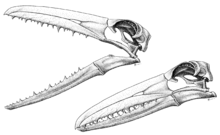Pelagornis sandersi
Pelagornis sandersi is an extinct species of flying bird, whose fossil remains date from 25 million years ago, during the Chattian age of the Oligocene.[2] The sole specimen of P. sandersi has a wingspan estimated between 6.1 and 7.4 m (20 and 24 ft),[1][3] giving it the largest wingspan of any flying bird yet discovered, twice that of the wandering albatross, which has the largest wingspan of any extant flying bird (up to 3.7 m (12 ft)).[3]
| Pelagornis sandersi Temporal range: Upper Oligocene | |
|---|---|
 | |
| Restored skull | |
| Scientific classification | |
| Kingdom: | Animalia |
| Phylum: | Chordata |
| Class: | Aves |
| Order: | †Odontopterygiformes |
| Family: | †Pelagornithidae |
| Genus: | †Pelagornis |
| Species: | †P. sandersi |
| Binomial name | |
| †Pelagornis sandersi Ksepka, 2014[1] | |
In this regard, it supplants the previous record holder, the also extinct Argentavis magnificens. The skeletal wingspan (excluding feathers) of P. sandersi is estimated at 5.2 m (17 ft) while that of A. magnificens is estimated at 4 m (13 ft).[4]
Some scientists expressed surprise at the idea that this species could fly at all, given that, at between 22 and 40 kg (48 and 88 lb), it would be considered too heavy by the predominant theory of the mechanism by which birds fly.[5] Dan Ksepka of the National Evolutionary Synthesis Center in Durham, North Carolina, who discovered the new species, thinks it was able to fly in part because of its relatively small body and long wings,[6] and because it, like the albatross, spent much of its time over the ocean.[7]
Discovery
The only known fossil of P. sandersi was first uncovered in 1983 at Charleston International Airport, South Carolina, discovered by James Malcom, while working construction building a new terminal there. At the time the bird lived, 25 million years ago, this area was an ocean.[7] The bird is named after Albert Sanders, the former curator of natural history at Charleston Museum, who led the excavation.[4] It currently sits at the Charleston Museum, where it was identified as a new species by Dan Ksepka in 2014.[2] "Though no feathers survived, Ksepka extrapolated the mass, wingspan and wing shape from the fossilised bones and fed them into a computer to estimate how the bird might fly. A conservative estimate put the wingspan of P. sandersi at around 6.4 metres (21 feet)."[8]
Physiology

P. sandersi had short, stumpy legs, and was probably able to fly only by hopping off cliff edges. It has been estimated that it was able to fly at up to 60 km/h (37 mph).[8] Like all members of the Pelagornithidae, P. sandersi had tooth-like or knob-like extensions of the bill's margin, called "pseudo-teeth," which would have enabled the living animal to better grip and grasp slippery prey. According to Ksepka, P. sandersi's teeth "don’t have enamel, they don’t grow in sockets, and they aren’t lost and replaced throughout the creature’s life span."[7]
Comparison to pterosaurs
While P. sandersi's wingspan of 6.1–7.4 m (20–24 ft) is believed to be the largest known among birds, it is still far from the largest known flying animal. Flying pterosaurs such as Hatzegopteryx and Quetzalcoatlus are believed to have reached wingspans of up to 10–11 m (33–36 ft).[9] However, the wingspan of P. sandersi was similar to that of Pteranodon, another large well-known pterosaur.
References
- Ksepka, D. T. (July 7, 2014). "Flight performance of the largest volant bird". Proceedings of the National Academy of Sciences. 111 (29): 10624–10629. doi:10.1073/pnas.1320297111. PMC 4115518. PMID 25002475. Retrieved July 8, 2014.
- Osborne, Hannah (July 7, 2014). "Pelagornis Sandersi: World's Biggest Bird Was Twice as Big as Albatross with 24 feet (7.3 m) Wingspan". International Business Times. Archived from the original on July 7, 2014. Retrieved July 7, 2014.
- Morelle, Rebecca (July 7, 2014). "Fossil of 'largest flying bird' identified". BBC News. Archived from the original on July 7, 2014. Retrieved July 8, 2014.
- Choi, Charles Q. (July 7, 2014). "World's largest flying bird was like nothing alive today". Fox News. Archived from the original on July 8, 2014. Retrieved July 7, 2014.
- Hotz, Robert Lee (July 7, 2014). "Scientists Identify Largest Flying Bird". Wall Street Journal. Archived from the original on July 11, 2014. Retrieved July 7, 2014.
- Khan, Amina (July 7, 2014). "Fossil's 21-foot wingspan shows Pelagornis was 'largest flying bird'". Los Angeles Times. Archived from the original on July 8, 2014. Retrieved July 8, 2014.
- Feltman, Rachel (July 7, 2014). "A newly declared species may be the largest flying bird to ever live". The Washington Post. Retrieved July 11, 2014.
- Karim, Nishad (July 7, 2014). "Fossils dug up at airport may be largest flying bird ever found". The Guardian. Archived from the original on July 8, 2014. Retrieved July 7, 2014.
- "Hatzegopteryx". BBC Nature. 2014. Archived from the original on March 27, 2014. Retrieved July 8, 2014.